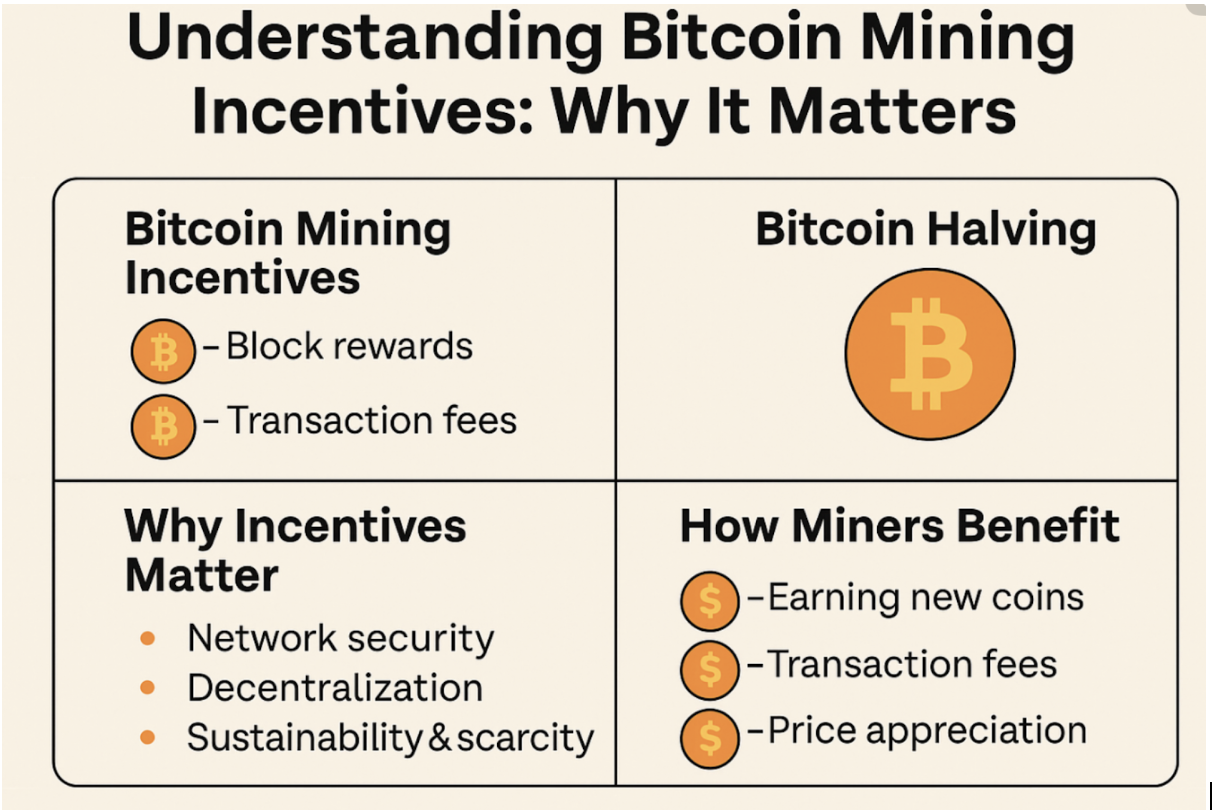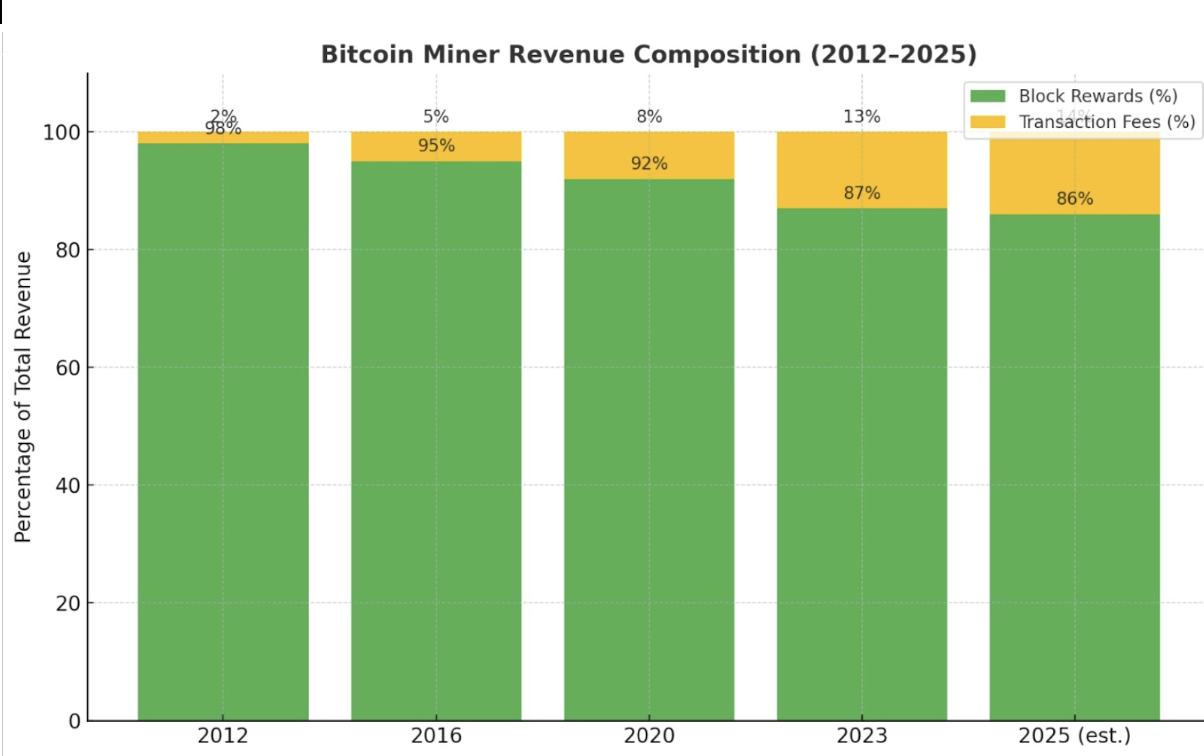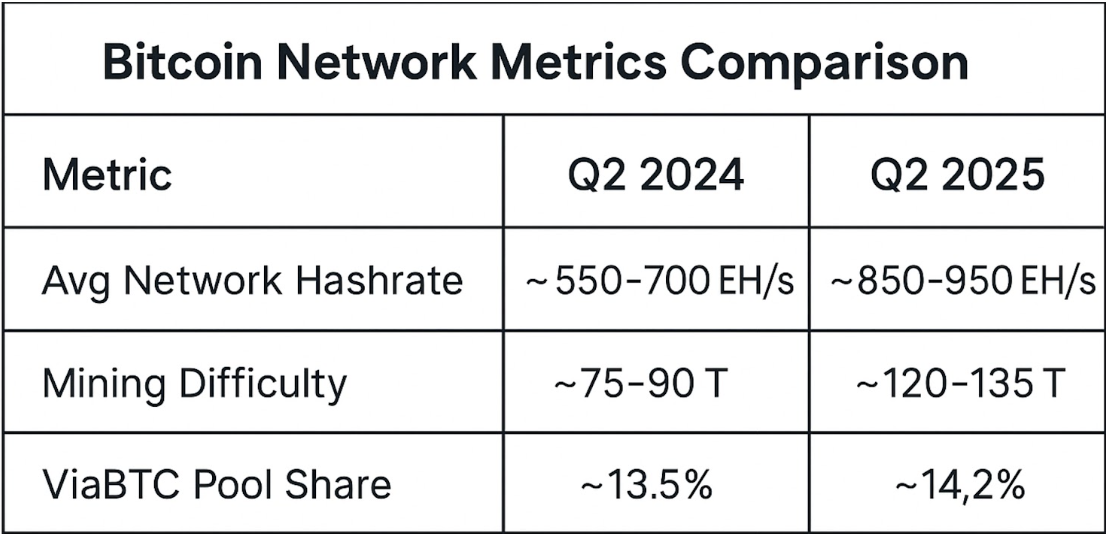Bitcoin mining incentives are the economic engine behind the Bitcoin network’s security, decentralization, and long-term growth. These incentives not only reward miners for validating transactions and securing the blockchain but also ensure competition and innovation in an evolving market. With Bitcoin completing its fourth halving and facing record-high mining difficulty in 2025, understanding mining incentives is crucial for miners, investors, and enthusiasts who want to thrive in this competitive environment.

Did you know?
After the 2024 halving, Bitcoin’s daily issuance dropped from around 900 BTC/day to 450 BTC/day, amplifying the significance of transaction fees and operational efficiency.
Incentive Mechanisms of Bitcoin Mining
Bitcoin mining uses proof-of-work (PoW), where miners solve cryptographic puzzles to validate transactions and create new blocks. This process is energy-intensive and requires advanced application-specific integrated circuits (ASICs) and significant electricity costs, necessitating strong economic incentives.
Types of Incentives
- Block Subsidy: Newly created Bitcoins given to miners who successfully mine a block. When Bitcoin launched in 2009, the reward was 50 BTC per block. This halves roughly every 210,000 blocks (~4 years) in a scheduled event known as the Bitcoin halving. After the 2024 halving, block rewards are 3.125 BTC, gradually decreasing until the final Bitcoin is mined (~2140).
- Transaction Fees: Users pay transaction fees to incentivize miners to include their transactions in blocks. As block subsidies shrink, transaction fees become increasingly critical.
These rewards together sustain mining profitability, ensure network security, and uphold Bitcoin’s deflationary monetary policy.
Automatic Difficulty Adjustment
Bitcoin’s mining difficulty automatically adjusts every ~2 weeks, ensuring a stable average block time of ~10 minutes regardless of total network hashrate. This self-regulating mechanism keeps the blockchain stable even as competition intensifies.
More reading: ViaBTC Blog – Mining Basics & Halving Explained.
Table 1: Bitcoin Halving History & Impact on Block Rewards

Projection based on average 10-minute block intervals.
Importance of Bitcoin Mining Incentives Beyond Price
Mining incentives aren’t just about miner earnings; they ensure Bitcoin’s trustless design and ecosystem growth.
Securing the Network
Without rewards, miners would have no incentive to spend resources validating transactions. Mining incentives ensure miners act honestly, making attacks such as double-spending or a 51% majority attack prohibitively expensive.
Promoting Decentralization
Predictable rewards attract miners globally, spreading hash power geographically and reducing the risk of centralized control. In 2025, mining hubs span North America, Europe, Central Asia, and Africa, ensuring censorship resistance.
Sustaining Long-Term Economic Viability
As subsidies decline, transaction fees become increasingly crucial. This gradual transition ensures Bitcoin remains secure even after all 21 million BTC have been mined.
Enhancing User Confidence & Network Stability
Consistent mining incentives maintain predictable confirmation times and reduce network congestion, essential for Bitcoin adoption and everyday use.
Driving Environmental Efficiency
Lower block rewards motivate miners to adopt energy-efficient ASICs and renewable power sources. In 2025, ESG (Environmental, Social, and Governance) compliance is a priority, and many miners are integrating solar, wind, and hydro energy to stay profitable and meet regulatory standards.
How Miners Benefit from Bitcoin Mining Incentives
Bitcoin mining incentives do more than simply reward miners for validating transactions; they create a sustainable financial framework that supports network security and decentralization while ensuring miners remain profitable even in a competitive environment. For miners, these incentives serve as the backbone of operational viability, influencing strategies around hardware investment, energy consumption, and market participation.
Direct Economic Rewards
Miners earn block rewards and transaction fees, offsetting costs such as electricity, cooling, and hardware. Transaction fees, which spiked during the 2024 halving congestion, are now a significant revenue component.
Income Stability via Mining Pools
Given soaring difficulty, solo mining is impractical for most participants. Mining pools like ViaBTC Pool aggregate hashing power and distribute rewards using transparent models such as PPS+, which guarantees fixed daily payments based on contributed hash power plus a fair share of transaction fees, reducing income variability.
Capital Appreciation
Many miners hold part of their earnings, benefiting from potential Bitcoin price appreciation and added upside in addition to block rewards.
Supporting Network Integrity
Miners secure the blockchain, maintaining Bitcoin’s reputation and encouraging institutional adoption, which increases long-term demand and profitability.
Advanced Infrastructure and Tools
ViaBTC supports miners with 24/7 technical assistance, global low-latency nodes, real-time analytics, and financial tools like:
- Profit Calculator for earnings estimates
- Crypto Loan for liquidity without selling assets
Table 2: Miner Revenue Composition Trend (Block Rewards vs. Transaction Fees)

Navigating the Halving Cycle
Halvings cut miner block rewards in half every ~4 years, forcing operational adjustments.
Operational Efficiency
Upgrading to high-performance, energy-efficient ASIC miners is critical. Efficient cooling, firmware optimization, and locating in regions with cheap or renewable energy further reduce costs.
Trusted Mining Pools
Joining transparent pools like ViaBTC Pool smooths revenue volatility and includes transaction fee payouts.
Transaction Fee Strategies
As fees grow in importance, miners benefit from monitoring mempool congestion and adjusting operations to capitalize on high-fee periods.
Difficulty Adjustments
Difficulty changes every 2 weeks. Monitoring these changes helps miners plan hash rate deployment and manage profitability effectively.
Market Volatility Preparation
Historically, halvings have preceded price surges, but miners shouldn’t rely solely on price speculation. Diversification and efficient operations remain key.
Environmental Responsibility
Shifting to renewable energy reduces costs and supports sustainability goals. Miners using ESG-compliant infrastructure may even attract institutional partners and financing.
ViaBTC Mining Innovations 2025
ViaBTC provides miners with solutions designed for today’s competitive post-halving environment.
- PPS+ Payout System: Ensures predictable payouts by combining fixed block rewards and transaction fees.
- Multi-asset mining: Offering BTC, BCH, LTC, and various other assets for mining, enabling miners to adjust their strategies based on market conditions to optimize returns.”
- Crypto Loans: Crypto Loan products offer liquidity while holding crypto assets long-term.”
- Advanced Analytics: Use ViaBTC’s mobile app and real-time dashboard to monitor performance and profitability.
- Global Infrastructure: Worldwide low-latency nodes with 24/7 multilingual support keep miners productive.
Mining Trends Snapshot

Emerging Trends Shaping Mining (2025 and Beyond)
- Institutional Mining: Professionalized mining operations with compliance and risk management.
- ESG Focus: Renewable energy and carbon-neutral strategies dominate new deployments.
- Technology Adoption: AI-based performance optimization, immersion cooling, and Stratum V2 are enhancing efficiency.
- Financial Sophistication: Miners increasingly use derivatives and collateralized loans for risk management.
Explore More: ViaBTC Blog – Future of Bitcoin Mining.
Conclusion
Bitcoin mining incentives are the cornerstone of blockchain security and economic sustainability. Miners who understand block rewards, transaction fees, and halving cycles and who leverage solutions like ViaBTC’s PPS+ payout, financial tools, and real-time analytics will remain competitive and profitable in 2025 and beyond.
Ready to optimize your mining?
Join ViaBTC Mining Pool today and explore ViaBTC Blog for expert strategies and updates.
Frequently Asked Questions (FAQ)
1. What are Bitcoin mining incentives?
They are rewards (block subsidies + transaction fees) paid to miners who secure the network and validate transactions.
2. How do halving events impact miners?
They reduce block rewards by 50% every ~4 years, requiring operational efficiency and fee-based strategies.
3. What benefits do mining pools like ViaBTC offer?
Stable earnings (PPS+ payouts), reduced reward variance, global nodes, and advanced analytics.
4. How can miners stay profitable post-halving?
Upgrade to efficient hardware, use renewable energy, join trusted pools, and monitor fee markets.
5. Is Bitcoin mining environmentally sustainable?
With renewable energy adoption and efficiency gains, miners are reducing their carbon footprint to meet ESG goals.
6. How does mining difficulty affect profitability?
Difficulty adjusts every ~2 weeks to balance network hash power, impacting reward share and operational costs.
Disclaimer: This article is for informational purposes only and does not constitute financial or investment advice.